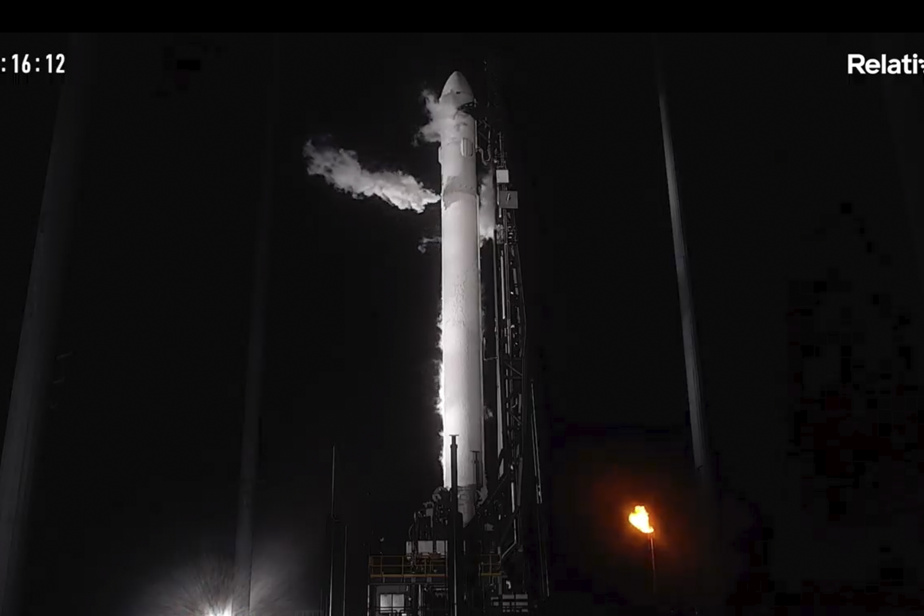(Washington) The third attempt will not have been good. The first 3D-printed rocket lifted off Wednesday from Cape Carnival, Florida in the United States, but failed to reach orbit due to an “anomaly” during second-stage separation, according to a live broadcast.
This third failure follows two previous attempts canceled at the last minute due to technical problems.
This mission, dubbed “Good luck, have fun” (“Good luck, have fun”, in French), is closely scrutinized because 3D printed rockets could represent a small revolution in the launch industry.
The Terran 1 rocket, from California-based start-up Relativity Space, was to collect data and demonstrate that a 3D-printed rocket could withstand the rigors of liftoff and spaceflight.
In total, 85% of the rocket’s mass was 3D printed, and the company is aiming for 95% in the future.
Main advantage of the technique: greatly simplifying the manufacturing process and thus reducing costs.
With its large 3D printing robots, the company claims to divide the number of parts by 100 compared to a traditional rocket. It also highlights the speed of the method: 60 days, from raw material to finished product.
Terran 1 is 33.5 meters tall and just over 2 meters in diameter. Its first stage has nine motors, also 3D printed.
Its objective: to be able to place 1250 kg in low earth orbit (small satellites, for example), which makes it a light launcher. But this first flight does not contain a payload.
The rocket should have reached, 80 seconds after liftoff, the point where the aerodynamic force exerted on the machine is the highest (max Q, in the jargon). This is the crucial stage of the flight, according to the young boss of Relativity Space.
“We have already proven on the ground what we hope to prove in flight — that when the dynamic pressure and strain on the vehicle is at its highest, 3D printed structures can withstand those forces,” Tim Ellis tweeted in early March.
After the first stage separated from the rocket, the second should have continued on its way until it reached Earth orbit — 8 minutes after liftoff.
Achieving this milestone on the first flight would have been “unprecedented,” said Tim Ellis.
Indeed, the rocket uses methalox as fuel, a mixture of liquid oxygen and liquefied natural gas (essentially methane). If it had managed to reach orbit, it would be the first rocket using this fuel to do so.
Relativity Space, which promotes the long-term vision of humanity living on multiple planets, argues that it is the fuel “of the future”, the easiest to produce on Mars.
The rockets in development Vulcan, from United Launch Alliance (ULA), and Starship, from SpaceX, must also use this fuel.
A first attempt to launch Terran 1 was aborted on March 8 due to a fuel temperature issue.
Then, on March 11, the takeoff was canceled twice in the final seconds of the countdown, first due to an automation issue, then due to a fuel pressure concern.
No matter how successful Terran 1’s maiden flight is, the data collected will also be used in the development of its big sister: Terran R.
This larger rocket, also developed by Relativity Space, will have to be able to transport 20,000 kg to low orbit.
The company has already signed $1.65 billion in contracts, the majority for Terran R, according to Tim Ellis.
One of them was with the company OneWeb, whose constellation of satellites must provide internet from space.
This type of rocket “medium-heavy is clearly where the biggest market opportunity is for the rest of the decade, with a huge shortage currently in this payload class,” Tim Ellis tweeted.
A satellite operator can wait years before getting a place in the big rockets of Arianespace or SpaceX.
Dozens of start-ups have therefore launched in recent years to meet booming demand.
The number of satellites launched has increased from around 120 in 2012 to more than 2,700 in 2022, according to the specialist company Euroconsult.

